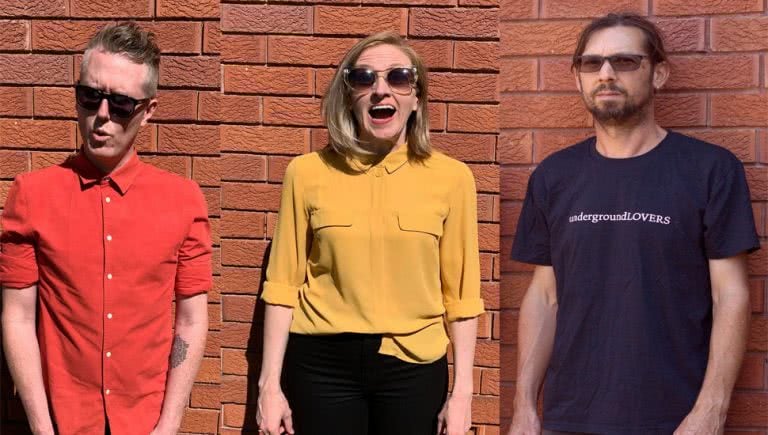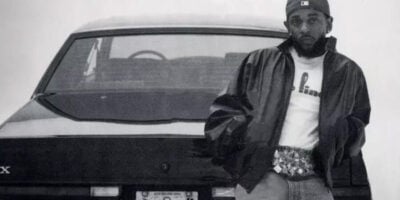With Key Out having released their new album, Anthropomorphia, on Friday, Paddy Haid chats with Half A Cow’s Nic Dalton about their latest record.
Back in September of 2016, Sydney trio Key Out released their debut album, Seeing The Sky And The Stars, which helped cement their status as one band which not only commands, but deserves, your attention. Two years later, they followed it up with the equally-impressive What (do) you see, which was released on the beloved Aussie label, Half A Cow records.
On Friday, the trio – made up of Paddy Haid, Rohan Geddes, and Caroline Wake – shared their latest album, Anthropomorphia, following the release of singles such as ‘Chorus’ and the exceptional ‘Stray’.
Recorded by Wayne Connolly (Amy Shark, Matt Corby), this 23-minute release whips past the listener, leaving you with stylistic flashes of electroish-post punk, filtered summery pop, and close mic’d folk once all is said and done.
Easily one of the group’s most accomplished and enjoyable releases to date, it’s always an enjoyable experience to hear what the average listener thinks of the record as they take the time to experience and consume its content, but its rare that the head of the album’s label gets a chance to weigh in on the new release.
In celebration of Anthropomorphia’s release last week, Half A Cow records’ Nic Dalton has spoken to Key Out’s Paddy Haid about their brand new album, going deep into questions of production, composition, and even future live performances.
Check out ‘Stray’ by Key Out:

Love Music?
Get your daily dose of metal, rock, indie, pop, and everything else in between.
Nic Dalton: I was listening to the difference between Greg Walker and Wayne Connolly’s mixing duties between the new album and What (do) you see. They both have a lot of ‘space’. How did their approaches differ?
Paddy Haid: We made What (do) you see, while staying in a remote cabin in Gippsland complete with wood heater. We did live takes to tape in Greg’s beautiful space through his Neotek desk. That setting and Greg’s approach of capturing and enhancing unusual elements coloured that sound.
We spent the week talking records, recording philosophy, drum mic’ing techniques, and that experience gave us the confidence to try to do the next recording ourselves.
Anthropomorphia was made in less grand surrounds – in a bedroom at home – and over a summer rather than a week. We only had a couple of mics, but a lot more time to experiment and find the sounds we wanted. We initially had designs on mixing it ourselves too but were really happy with the recording and so gave Wayne a call and are really glad we did.
He found space for all the guitars, layers of synths and vocal harmonies with reverbs, filters and other tricks in place of a big live room.
ND: The new album reminds me of The Cure’s Pornography album. At the time, it was quite a detour to what came before.
PH: That’s not a reference point that I had thought of, but I’m flattered. I can see some parallels with the chorus bass, synths and reverb drums and I think this record is a bit of a detour for us too. Hopefully we can follow it up with a Disintegration sometime in the future.
ND: I pulled out your Line Drawings cd from 2007 and it’s definitely ‘Paddy from Key Out’. Has all your song writing followed a similar path or is there a shelved hillbilly-metal album in your shoebox?
PH: I have mined a deep vein of obtuse indie-pop in the recent past. I’m more embarrassed than I thought I would be admitting that there is no hillbilly-metal album. But we’ve only scratched the surface of the sequencing and FM synthesis worlds, so maybe we’ve got an unexpected turn that way in the future.
Check out Key Out’s ‘Fire’:
ND: ‘Fire’ has those MBV bendy sounds in the intro; Was that you or Wayne’s doing?
PH: That was my doing, and that ‘intro’ is actually the middle of the song as we originally recorded it. After doing a mix, I thought it would sound better chopped in half, so I recorded some analog radio dial tuning and used it as a shortcut into the back end of the song which was much more interesting than the front half.
ND: I like the occasional acoustic guitar throughout the album. Do you mainly write on acoustic or electric?
PH: All of these songs were written and demoed on electrics, and generally as angular rock songs. We started putting some acoustic doubles on here and there, and muted some electrics and there was just so much more space. Some of the songs just fell into place the more we took away while trying to add to them.
ND: The drums – or drum machine – sound fantastic on the album. How did you get such a great sound. Some of it reminds me of the music I used to dance to in the early 80s!
PH: The drums were a bit like the guitars. We tracked them all with a real kit, but started playing around with samplers, drum machines and shakers, and enjoyed the space as we subtracted things. Most songs are a combination of loops, 909 samples (which are probably responsible for a lot of the ’80s vibe), home-made shakers and live drums.
Check out Key Out’s ‘Echolocation’:
ND: ‘Echolocation’ has no drums – is it too slow? Were they pulled out during mixing?
PH: We recorded a nice rolling waltzy beat but pulled it out while dubbing at home. There is an unusual guitar tuning (GGEGBE) which helped accentuate the percussive Elliott Smith-like string squalls on certain chords that we liked, and that along with a shaker made from Christmas cracker bells felt like enough structure.
ND: Will you add anything new when you play out live again? Will Rohan stick to the kit?
PH: Yes (one way or another)! We’re currently trying to work out the best way to use six hands to play all these new songs. Rohan has been playing some bass at practice, and we’re getting closer.
ND: Lyrically, what inspires you? Does the music come first?
PH: All of these songs are about, written through or sparked by different animals I know – anthropomorphised and used as vehicles to say different things.
The approach is borrowed from a book called Only The Animals by Ceridwen Dovey which looks at different historical and artistic moments through the eyes of different creatures. And although there was a clear concept and idea for this record, the music came first for all songs.
ND: ‘Chorus’ is a very catchy song. I find it amusing having an earworm of a chorus that says chorus. Very clever. That’s all!
PH: Thanks! It was our first attempt at using the drum machines, and putting together something to (potentially) dance to. You’d need to be a bit of an odd dancer to get into that groove, but at least it’s uptempo. We were also playing around with repetition and absurd ideas. A chorus of one fit well.
Key Out’s Anthropomorphia is available for streaming and purchase now. Keep up to date with the group via their Facebook, Instagram, and Bandcamp pages, and be sure to peruse the inimitable Half A Cow catalogue on Bandcamp, too.
Check out ‘Chorus’ by Key Out:



































